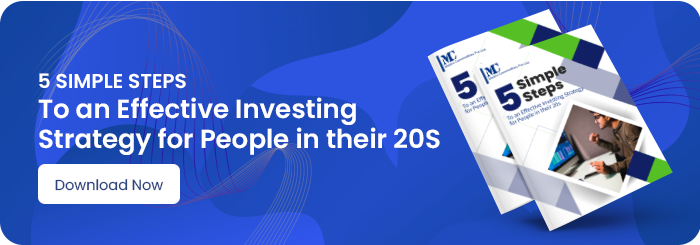An investor's goal is to maximise profits on assets while minimising risk. They want to find the best investment plan where they can double their money in a few months or years with little or no risk. Unfortunately, there is no financial option that offers both high returns and little risk. There is a link between risk and reward. For example, bigger returns mean more risk, and vice versa. Low-risk investments provide investors with peace of mind since they are designed to avoid losses. Before deciding on an investment strategy, it is important to match your risk profile to the product's associated risks. In this article, we are going to take a look at 10 low-risk stock market investment options.
When Should You Choose Low-Risk Investments Over High-Risk Investments?
You may wish to consider low-risk investing if you meet any of the following criteria:
- You have a portfolio full of risky investments and want to protect yourself.
- When you have an emergency fund, you need a place to keep it.
- You want to invest but are afraid of taking risks.
If you find yourself in any of the above scenarios, you can select one of the following alternatives.
1. Dividend paying stocks.
Dividends are regular financial payments made to shareholders by steady, profitable corporations. Investing in dividend-paying stocks might provide some degree of security in an otherwise volatile market. They can provide both fixed income and capital appreciation for investors.
Even if dividend-paying companies' share prices don't climb as rapidly or to the same heights as those of growth-stage firms, their dividends and stability make them attractive to investors. Choosing dividend-paying firms requires some caution, despite their low-risk nature.
| Pros | Cons |
|---|---|
|
|
2. Index ETFs
The idea of Index ETFs is very simple. ETFs are portfolios (or a basket of stocks bonds or commodities) that mirror the composition of an index, like S&P CNX Nifty or BSE Sensex. An ETF can be traded on an exchange which makes it attractive to a large number of investors.
The net asset value of the underlying stocks or commodities that the ETF represents determines the current trading value. If you're looking for an easy way to diversify your portfolio through passive investing, without taking on too much risk, ETFs may be the answer.
| Pros | Cons |
|---|---|
|
|
3. Debt mutual funds
A debt fund is a type of mutual fund scheme that invests in fixed income instruments that provide capital appreciation, such as corporate and government bonds, corporate debt securities, and money market instruments, among other things. It's a smarter option that seeks to outperform fixed deposits in terms of return.
They provide higher yields and more tax advantages. The interest earned on bank fixed deposits is taxed as part of an individual's income, whereas capital gains on debt funds are taxed at the lower rates currently in effect.
| Pros | Cons |
|---|---|
|
|
4. Hybrid mutual funds
Depending on the investment aim, hybrid funds may invest in stocks, debt, or other asset types. These funds invest in a variety of assets to diversify their portfolios and reduce risk. Some hybrid funds have a larger equity ratio, while others have a higher debt exposure. Hybrid funds can outperform debt funds while being less risky than equity funds.
| Pros | Cons |
|---|---|
|
|
5. Unit linked insurance plans (ULIPs)
A ULIP is a type of insurance plan that combines investment and life insurance to safeguard your family financially in case of an unexpected event. The ULIP premium is split into two parts. Part of it goes to your insurance coverage, and the rest goes into the fund of your choice. The type of fund you invest in depends on your risk tolerance and investment objectives. ULIPs are therefore suitable low risk long-term investment options for you and your family.
| Pros | Cons |
|---|---|
|
|
Get Free ebooks, guides & templates delivered to your email
We promise never to spam.
6. Money Market Funds
A money market fund is a type of mutual fund that invests in short-term, highly liquid assets. Cash, cash equivalents, and short-term debt securities with excellent credit ratings are some examples of these instruments. The goal of money market funds is to provide investors with a high level of liquidity while also reducing their exposure to risk.
| Pros | Cons |
|---|---|
|
|
7. Gilt funds
In a gilt fund, investors put their money into the government's bonds. In the past, the government issued bonds in the form of certificates with golden edges. The term "gilt" comes from the gilded edges of certificates that were given out. In accordance with SEBI guidelines, gilt funds are required to hold at least 80% of their capital in government bonds.
Gilt funds have a reputation for delivering moderate returns with little to no risk. People with short-to medium-term goals might benefit from investing in these funds.
| Pros | Cons |
|---|---|
|
|
8. National Pension System (NPS)
The government of India formulated the National Pension System (NPS) as a retirement benefit program to provide a steady income to all subscribers after retirement. An independent agency called PFRDA (Pension Fund Regulatory and Development Authority) is in charge of overseeing NPS's operations.
Everyone should plan for their retirement. You need to save enough for your golden years when you won't be able to work full-time and make money. It will benefit you when you retire and receive a monthly pension (income).
Section 80C and Section 80CCD of the Income Tax Act allow you to claim a deduction of 1,50,000 rupees and an extra benefit of 50,000 rupees. Anyone with a low-risk appetite and an expectation of retiring comfortably should invest in NPS. Apart from government employees, private-sector employees who want a steady pension after retirement should choose this option.
| Pros | Cons |
|---|---|
|
|
9. Gold BeES
Gold BeES is an open-ended exchange-traded fund (ETF) that provides a one-of-a-kind investment opportunity for those interested in gold. Before expenditures are taken into account, investments in the Gold Benchmark Exchange Traded Scheme (Gold BeES) aim to offer returns that are roughly identical to the domestic gold price returns on physical gold.
Due to the fact that these are ETFs, they may be traded on the stock exchange. Gold is seen as a valuable hedge against inflation.
| Pros | Cons |
|---|---|
|
|
10. REIT
A real estate investment trust (REIT) is a kind of corporation that owns, operates, or funds income-producing real estate assets. REITs are like mutual funds in that they pool the money of many people. REITs can be listed on a stock market like any other security, and its units can be traded on the stock exchange.
| Pros | Cons |
|---|---|
|
|
Summary:
These investment options include both fixed-income and market-linked assets. Maintain a well-balanced portfolio by considering factors like return, risk, and taxation. Market-linked investments have great potential for profits, but also carry substantial risks. Fixed-income investments assist in preserving the capital that has been earned so that the intended aim may be achieved. Long-term objectives of wealth creation require combining the best of both.






